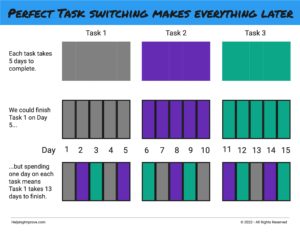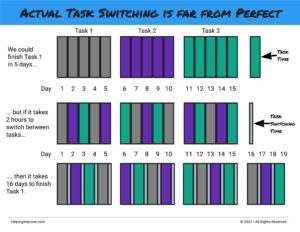
Most people and organizations want to have an impact. They don’t exert effort for no purpose; they want to accomplish something. Waste – spending time and energy on things that don’t contribute to an outcome you want to create – gets in the way of that. Wasteful activities reduce our personal and organizational effectiveness. Waste comes in many different forms, and one of the most pernicious is task switching.
We will first examine what task switching is, how it is wasteful, and what factors make it more likely. There are situations in which some degree of task-switching can make sense, and we’ll explore that as well. Most of the time, however, it doesn’t come from a conscious decision. If you decide that you want to switch less, we’ll look at some actions you can start with.
What is Task Switching?
Task switching is working on something new before you’ve finished something else. Some people call this multi-tasking. With very few exceptions, however, we can’t work on two things at once. What we’re doing is switching back and forth between multiple tasks. It looks something like this: You work on the copy for next quarter’s marketing campaign for a bit, and then you send out some (but not all) of the invites for next week’s kickoff meeting. After that, you track down the spreadsheet format you need to use for the expense report you’re going to file on Friday before setting that aside and coming back to work on the same piece of copy that you didn’t quite finish earlier.
In a software team, task switching often looks like starting to update a portion of the app to use the new style guidelines and windowing toolkit before discovering they need to talk with a usability expert (who isn’t part of the team) about something ambiguous in the document. While they wait to have the conversation, they start updating the business logic in a regulated portion of the app to conform to new government requirements. That gets stuck waiting on legal review, so they decide to start migrating one of their internal toolchains to the latest version of a third-party library, which they had been deferring for a while. In the middle of that, they get a notification from IT that a new security vulnerability has been discovered, so they need to install a patch and reboot their workstations and servers immediately. In the middle of that, the usability expert calls back…
Each time we move from one unfinished task to another, we are engaged in task switching.
Task Switching Creates Delays

What’s the problem with task switching? It creates waste in multiple ways. One is that it delays the delivery of a finished product. Even “free” task switching – when you can switch instantaneously from one task to the next – makes everything later. Imagine that you have three tasks that will take five days each. Suppose that you work on one for a day, then switch to the next one on the second day, and then switch to the third on day three before returning to the first task on day four. As shown in Figure 1, if you keep doing this, then the first task – which would have finished on day five if you had worked on it straight through – completes on day thirteen. The second task finishes on day fourteen instead of day ten, and the third task still ends on day fifteen. By switching between tasks like this, you don’t complete any of them sooner, earlier, and you finish all but one later than if you hadn’t switched at all.
Even perfect task switching creates wasteful delay.
Task Switching Has Costs

But it’s worse than that. Actual task switching is not free. Most of the time, we need to do some setup for a task. That might involve arranging the workspace, gathering materials, or finding the information we need. This setup time is rarely instantaneous; it takes time. For our three hypothetical 5-day tasks, imagine it takes you a quarter of a day to switch between them – say, one hour of closing out the previous task and then another hour of setting up the next task. In this case, as shown in Figure 2, switching between the three tasks causes the first task to finish on day sixteen and the third task on day nineteen. You could have incurred that two-hour cost just twice (when you finished the first and the second tasks), but instead, you paid it fourteen times. That’s 24 hours of unnecessary switching time – three days of waste.
Perfect task switching creates delays. The delays from actual task switching are even worse.
Knowledge Work Has Switching Costs, Too
While the time it takes to switch tasks is obvious when there is a need to gather physical equipment and other materials, these costs are also present in knowledge work. As Mary & Tom Poppendieck point out in Implementing Lean Software Development:
Switching to a different task is not only distracting, it takes time and often detracts from the results of both tasks. When knowledge workers have three or four tasks to do, they will often spend more time resetting their minds as they switch to each new task than they spend actually working on it. This task switching time is waste.
For decades, psychologists have studied the cost of task switching and its negative impact on the quality of the work done – another potential waste. One current theory about the source of switching costs is that to switch to a new task your brain has to do two things. First, it has to update the goal it is oriented towards. It takes time and energy for the brain to convince itself, “I now want to be sending out invites for next week’s kickoff instead of writing copy for the marketing campaign.” Second, it must load the skill and knowledge required to do the new task. Again, it takes time and energy for the brain to make the transition from “Here’s how I write copy for the marketing campaign,” to “Here’s how I send out invites for next week’s kickoff.” Because you have to do both of these things – which psychologists call goal shifting and rule activation – it’s hard to design a switching method that doesn’t trigger one or both of them. (For more research on goal shifting and rule activation, see Rubinstein, Meyer, and Evens’ paper “Executive Control of Cognitive Processes in Task Switching”).
But remember: Even with no task-switching costs, task switching still makes everything later.
When Do We Task Switch?
If task switching is so costly, why do we do it so often? Most human behavior results from individual interactions with complex and often unconscious forces in the environment. Task switching is no different, so its causes are systemic. It is more likely to occur when certain conditions are present. Here are some conditions that contribute to our tendency to switch between tasks:
- When we don’t notice it – or its costs. As we saw above, the costs of task switching are often invisible. We often don’t realize that we’re creating delays in delivery or spending unneeded time and energy on switching. Sometimes we don’t even realize that we are switching between tasks until we make a log or tell someone the story of our day. It’s subtle, so it’s easy to miss unless we pay attention to it. When we aren’t, it’s more likely to happen.
- When we encounter frequent delays. Task switching is also a common response to delays or other obstacles in our work. We need approval from legal to finish this feature, and we know it will take three days for them to get back to us, so we start something new. Of course, we’re in the middle of that when they do get back to us, so we get to pay the switching cost again… The more dependencies and waiting you have in your work environment, the more that task switching seems necessary. It can be a helpful response to coping with latencies and dependencies in a system. However, it also hides systemic problems and removes incentives to fix them.
- When we focus on doing things instead of getting things done. One way to address latencies in a system is to make them visible. Having frequent conversations about how often the delays that encourage wasteful task switching occur makes them more likely to get addressed. These conversations rarely happen in organizations that believe that “staying busy” or “working hard” is the key to success. Instead of raising the issue, people believe that they must work at 100% all the time, so they work around it. I call this “confusing motion with progress.” We’re doing a lot but don’t realize it’s not us getting anywhere. In situations where this type of thinking is common, there is likely to be more task switching.
- When we have unclear (or no) priorities. When we don’t know that one of our three tasks is substantially more important than the other two, it’s easier to justify toggling between them (even though we are creating unnecessary delays). Working on multiple things simultaneously is often a symptom of unclear priorities. When it is clear that a certain task is our top priority, we are much more likely to work on it until it is done and draw attention to delays that keep us from working on it. We are much less likely to let interruptions derail us when we can tell that they are a lower priority than what we are working on. Having twenty (or more) “top priorities” is a good sign that you’re switching between tasks a lot.
Task Switching is Always Bad, Right?
Task switching always creates waste, but it’s not always bad. Doing some task switching might be a way to create less waste than your other choices.
I was on a software development team that limited its work in progress to one item at a time. The whole team focused on a single user-facing piece of functionality simultaneously. This was an incredibly efficient and effective way to work most of the time. When someone on the team had a question, they didn’t have to wait for an answer; the person who could answer it was right there. They would usually go from an idea to deployed software in less than a day. When they did have to wait on something, they’d look at ways to either reduce the wait time or proceed without waiting at all. What this didn’t work for, however, was learning from what they deployed. To verify a feature had the effect they wanted, they sometimes needed to gather a minimum amount of customer feedback and usage data. This required the new software to be available for about a day. When they didn’t gather this feedback – or if they didn’t act on it immediately after they got it, they ended up doing more work and dealing with more interruptions down the line. So when they deployed a feature that they needed to learn about, they would pick up a new piece of work – but never more than one. They found that their long-term throughput was highest when their work-in-process limit was two. If it was more than two, the cost of task switching was too high. If it was one, they either stalled or created more work for themselves in the future. They weighed the costs and made a transparent decision about how many tasks they were willing to switch between.
Another case where switching tasks can be worth the cost is when we need to mentally process things in the background while we do something else. (Thinking about something else while we engage in simple, almost automatic work is one of the few cases where we can multi-task.) I often take a break from creating something or trying to solve a challenging problem when I notice my energy or concentration flagging – or when I’m stuck. When I don’t know how to proceed, I’ll do something physical that doesn’t require much conscious attention – like putting away dishes, going for a walk, or even taking a shower. My brain is still working on whatever I was stuck on – and it usually finds an answer. But note that this is about pausing a task that requires a lot of mental energy to take on one that doesn’t. In this case, we don’t incur much switching cost from either goal shifting or rule activation. When the second task does require our attention, however, we have to pay those costs, and we can’t keep working on the first task in the background.
These are two examples of pausing an unfinished task to work on something else because it makes sense. The critical part is that both involve a conscious decision to switch because it will lead to a better result – and less waste overall – than staying with the task at hand. Most of the time, the decision is unconscious, and this gets us into trouble.
What You Can Do About It
What can you do if you want to waste less time and energy on task switching? As I said before, simply intending to do less of it likely won’t give you the results you want. Task switching happens when the forces encouraging it are stronger than those discouraging it. If you want less task switching, work on the conditions that push you to do task switching. Here are some ways to start:
- Create awareness. Encourage people to notice (and perhaps keep track of) whenever they switch tasks. Discuss the wastes created by task switching and the reasons we do it. Ask people to start questioning the need to switch between tasks and to consider alternatives. Above all, avoid blaming or shaming people for their current past and current tendencies; that makes change less likely.
- Make it visible. Find ways to make it obvious when task switching is happening. Make delays clear by paying attention to work item age and task cycle time. Encourage people to talk about delays and latency in your process. Notice where they work around these by task switching. Work on the things they bring up.
- Establish clear priorities. Ask people what they believe their current number one priority is. Explore both their answer and your thinking if you disagree. Discover and resolve sources of confusing or conflicting priorities. Get curious if people are working on tasks that aren’t their top priority. Find out what is telling them that they should be doing that.
- Limit work-in-process. Set a limit for the maximum number of unfinished tasks you can have at any given time. Whenever you go over that limit, reflect on the conditions that led to it. Experiment with this limit, and see how that affects throughput and cycle time.
These aren’t the only way to address task-switching. They are an excellent place to start. You can never eliminate all waste. What these help you to do is make transparent decisions about it.








